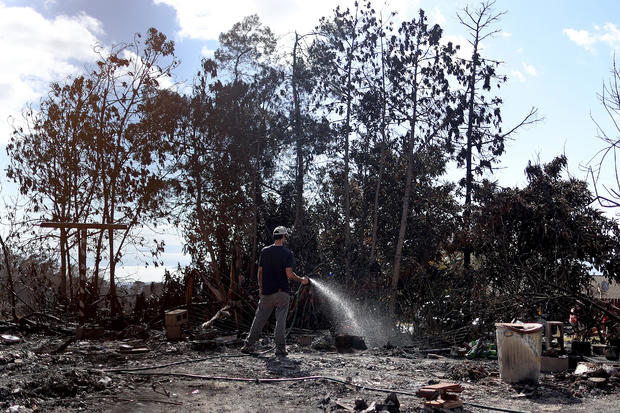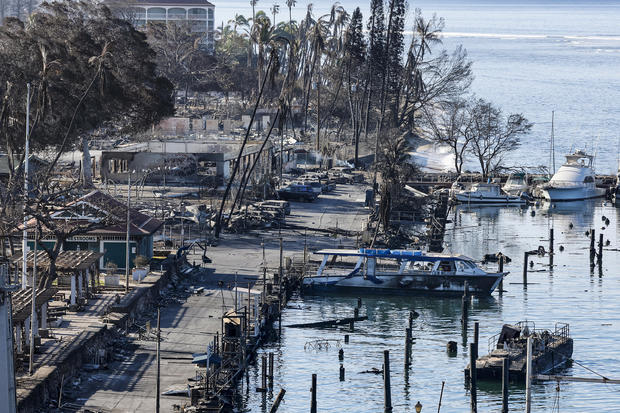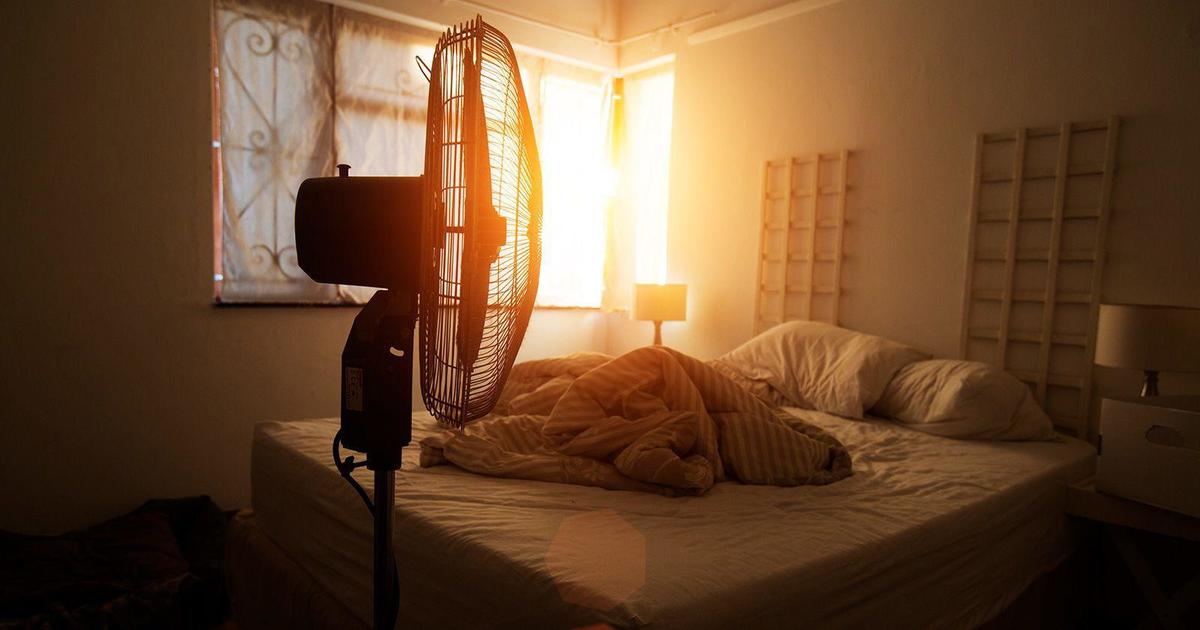Maui wildfires death toll rises to 93, making it the deadliest natural disaster in Hawaii since it became a state
The raging wildfire that swept through the picturesque town of Lahaina on the Hawaiian island of Maui last week has killed at least 93 people, authorities said Sunday, making it the deadliest natural disaster in Hawaii since it became a state in 1959.
Two of the fatalities have been indentified, Maui County officials said.
Maui County officials said early Sunday that firefighting crews are continuing to extinguish flare-ups in the Lahaina and Upcountry Maui fires. In the Upcountry Maui fire, three structures in Olinda and 16 structures in Kula were destroyed. On Saturday, the Pulehu/Kīhei fire was declared 100%, which indicates what percentage of the fire perimeter has been enclosed by a control line and reflects opportunities for the fire to spread beyond its original border into new areas.
A 1-acre fire reported Friday evening in Kaʻanapali, near Lahaina, above Puʻukoliʻi has been extinguished.
Hawaii's deadliest natural disaster since it became a state
The wildfires have become state's deadliest natural disaster in decades, surpassing a 1960 tsunami that killed 61 people. An even deadlier tsunami in 1946, which killed more than 150 on the Big Island, prompted development of a territory-wide emergency alert system with sirens that are tested monthly.
Hawaii emergency management records do not indicate the warning sirens sounded before fire hit the town. Officials sent alerts to mobile phones, televisions and radio stations, but widespread power and cellular outages may have limited their reach.
The newly released figure also surpassed the toll of the 2018 Camp Fire in Northern California, which left 85 dead and destroyed the town of Paradise. A century earlier, the 1918 Cloquet Fire broke out in drought-stricken northern Minnesota and raced through a number of rural communities, destroying thousands of homes and killing hundreds.
Hawaii Gov.: Death toll "is going to rise"
Hawaii Gov. Josh Green said operations Saturday would focus on "the loss of life" as he toured the devastation on Lahaina's beloved Front Street with representatives from the Federal Emergency Management Agency.
The Lahaina fire was the most devastating and destructive of three large wildfires which erupted on the island Tuesday.
"It's going to rise," Green remarked Saturday on the death toll as he toured the devastation on historic Front Street. "It will certainly be the worst natural disaster that Hawaii ever faced... We can only wait and support those who are living. Our focus now is to reunite people when we can and get them housing and get them health care, and then turn to rebuilding."
FEMA said the agency has been spray-painting cars and buildings on Front Street with an "X" to indicate they had received an initial check, but that there could still be human remains inside. When crews do another pass through, if they find remains, they will add the letters "HR" next to the "X."
As the death toll from the fires on the island rises, it's unclear how morgues will be able to accommodate the number of victims considering there is just one hospital and three mortuaries.
Beyond the confirmed deaths in Maui, hundreds of other people remain unaccounted for.
Search and rescue teams with cadaver dogs brought in from California and Washington had so far searched only 3% of the burn area, Maui County Police Chief John Pelletier disclosed in a news briefing Saturday afternoon.
He said that FEMA had agreed to bring in another 12 cadaver dogs.
"We can only go as fast as that animal can go," Pelletier said.
FEMA administrator Deanne Criswell said that 150 FEMA personnel were on the ground in Maui, and said more search and rescue teams were coming.
Pelletier also pleaded with residents who have missing family members get a DNA test.
"We need you to do the DNA test," Pelletier said. "We need to identify your loved ones."
Mike Rice has been looking for friends on the island but has yet to hear from them. It's too early to give up hope, he said, but he has not discounted possibility that they might have perished along with scores of others.
None of them had cell phones, he said, making his search for three members of the Hernandez clan all the more challenging.
"I think they could have very well made it out," said Rice, who now lives in California. "They may or may not have made it, I'm not going to sit around with a sense of impending doom waiting to find out."
Emergency managers in Maui were still assessing the scope of the damage Saturday in the center of Lahaina and searching for places to house people displaced from their homes.
In Saturday afternoon's news conference, Green said that the state had secured 1,000 rooms to temporarily house displaced residents and incoming support staff. Green said officials had to ensure the hotels had working electricity before they could be utilized.
"What we'd like to do is get people in as early as now," Green said. "But without stable power, once again, it will likely be tomorrow or Monday that we see the largest number of people get into housing."
Green said long-term rentals would be made available "in the coming days." Those rentals will be fully covered through a combination of state funding, FEMA funding and charitable donations, Green said.
The need for shelter was high, estimated to be as many as 4,500 people, according to the assessment posted by FEMA and the University of Hawaii's Pacific Disaster Center.
At least 2,207 structures were estimated to have been damaged or destroyed in the wildfires, according to preliminary numbers from the Pacific Disaster Center, which also estimated that rebuilding the island would cost a projected $5.5 billion.
There also was new information Saturday about the damage to boats, with nine confirmed to have sunk in Lahaina Harbor according to sonar.
Some 30 cell towers were still offline Saturday, and power outages are expected to last several weeks in west Maui.
At least two other fires have been burning in Maui, with no fatalities reported thus far: in south Maui's Kihei area and in the mountainous, inland communities known as Upcountry. A fourth broke out Friday evening in Kaanapali, a coastal community in West Maui north of Lahaina, but crews were able to extinguish it, authorities said.
Green said the Upcountry fire had affected 544 structures, of which 96% were residential.
Some residents in Lahaina have expressed frustration about having difficulty accessing their homes amid road closures and police checkpoints on the western side of the island.
On the south end of Front Street on Saturday morning, one resident walked barefoot carrying a laptop and a passport, asking how to get to the nearest shelter. Another person, riding his bicycle, took stock of the damage at the harbor, where he said his boat caught fire and sank.
One fire engine and a few construction trucks were seen driving through the neighborhood, but it remained eerily devoid of human and official government activity.
The cause of the fires remains unknown. As the Lahaina fire broke out Tuesday, it was accompanied by chaos and confusion. Emergency sirens weren't activated on the island. Resident also said the power was cut off, which gave them no access to television or radio. They also said they received no text alerts. Those in town only fled when the flames were on their heels.
Hawaii Attorney General Anne Lopez announced Friday that her agency would conduct a "comprehensive review of critical decision-making and standing policies leading up to, during, and after the wildfires."
The wildfires are the state's deadliest natural disaster in decades, surpassing a 1960 tsunami that killed 61 people. An even deadlier tsunami in 1946, which killed more than 150 on the Big Island, prompted development of a territory-wide emergency alert system with sirens that are tested monthly.





